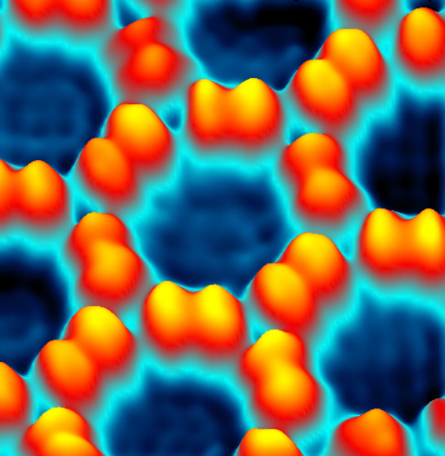Planar Carbon Lattices
RTG-2861-PCL
A5 - Formation and functionalization of PCLs
Principal investigator: Prof. Dr. Hans-Peter Steinrück, FAU Erlangen, [webpage]
Doctoral researcher in the 1st cohort: Majid Shaker
Doctoral researcher in the 2nd cohort: Open position
The preparation and functionalization of nanoporous 2D materials is a promising approach towards materials with interesting new properties. One promising route towards materials with very high lateral order are the formation of moiré structures of graphene and h-BN on lattice-mismatched metal substrates such as Rh(111) or Ir(111).[1] Due the strongly different coupling of the pore and rim regions (hills and valleys) of the moiré structures, electronically and chemically highly corrugated template structures are formed. This lateral variation of chemical reactivity allows for selective functionalization of the pore network. A second route to obtain very regular 2D pore lattices is the formation of metal-coordinated networks of organic molecules (Figure). In case of metalloporphyrins as building blocks, even specific catalytically active metal atoms can be inserted.[2],[3] Furthermore, the pore diameter can be tailored by the choice of the building blocks. Both types of planar pore lattices can, in a next step, be used as 2D templates for the formation of more complex functional structures or as lateral confined reactors for chemical reactions.

Figure: Kagome network of porphyrins on Cu(111).
Thesis topic 1st cohort: Metal-coordinated porous structures on metal surfaces
We aim at new routes for the formation and functionalization of PCLs, with a focus on lateral patterning. For this purpose, we study the formation of metal-coordinated networks on metal surfaces and 2D graphene or h-BN layers. We will prepare laterally structured PCLs by physical/chemical vapor deposition under ultraclean conditions in ultra-high vacuum. Particular focus will be given to porous networks built from functionalized molecular building blocks on different substrates, with the linking metal adatoms stemming from the substrate itself or from post- or predeposition of another metal. Thereby, the energetics and kinetics of the formation process, including diffusion of molecules and metal adatoms, and side reactions such as metalation or intra- or inter-molecular coupling are of relevance. The formed networks can serve as template for the deposition of molecules or particles with specific functionalities. We will apply synchrotron-based in situ XPS and UPS, NEXAFS, TPD, and variable temperature STM and AFM (100-500 K). Collaborations are planned concerning lateral patterning with Hirsch, low temperature STM with Maier, XPS satellites with Golze, and generally on characterization with various groups.
Thesis topic 2nd cohort: Local reactivity of pre-patterned PCLs
[2] H. Marbach, H.-P. Steinrück, Chem. Commun. 2014, 50, 9034.
[3] M. Lepper et al., Angew. Chem. Int. Ed. 2018, 57, 10074-10079.
